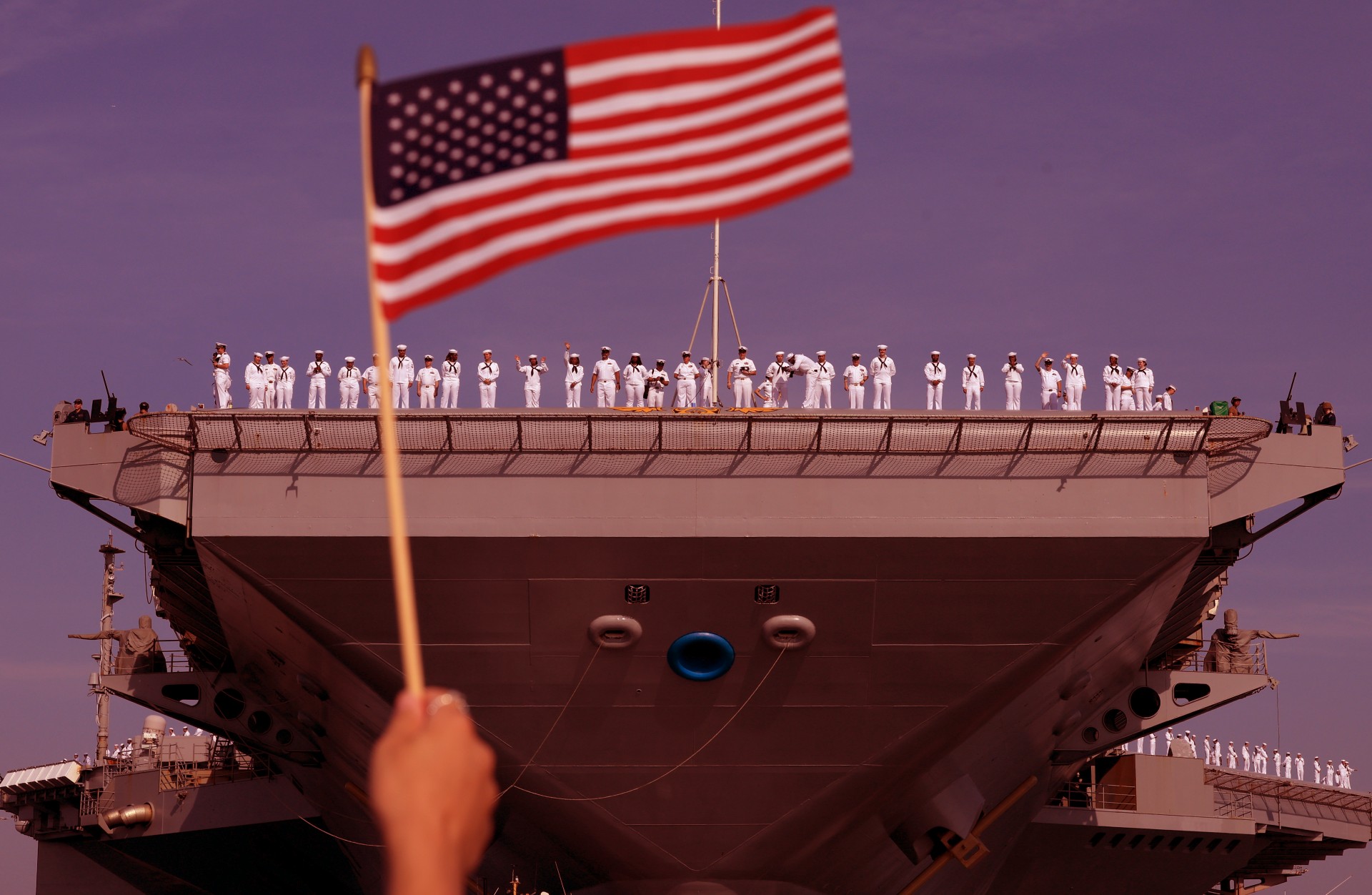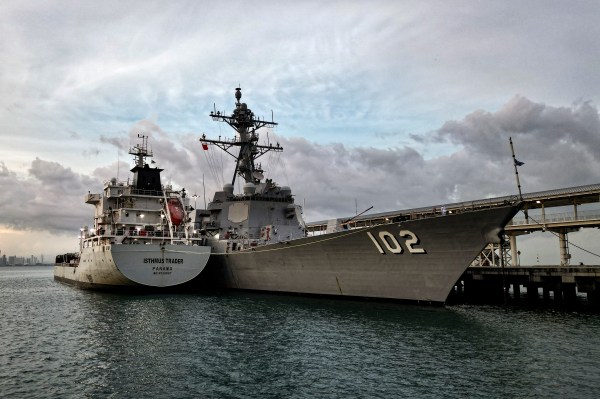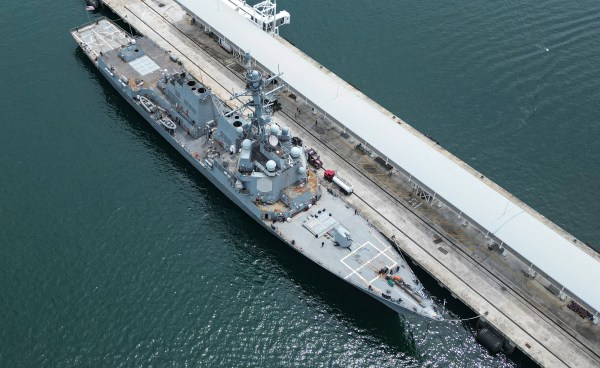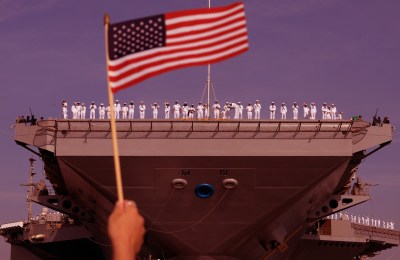Business is booming at the Changxing Island shipbuilding base. From 2020 to 2023, the Chinese island’s shipyards produced a total of 15 warships, including the Fujian aircraft carrier and five smaller but still plenty deadly frigates. Since then, China has launched what the Center for Strategic and International Studies (CSIS) believes to be a first-in-class drone-carrying amphibious assault ship, and has begun construction on an aircraft carrier that may be nuclear-powered.
China’s supercharged shipbuilding industry is cranking out warships at a rate unprecedented since World War II. Their shipbuilding output comprises 53.3 percent of total global tonnage—more than all other countries combined. The People’s Liberation Army Navy (PLAN) fleet is now the largest in the world, on track for 395 ships by the end of 2025 and around 430 by 2030. The Chinese shipbuilding industry and the PLAN, therefore, are forces to be reckoned with.
The U.S. Navy, on the other hand, maintains just under 300 battle force ships—commissioned and deployable vessels that count toward the official size of the U.S. fleet—and will do so for the foreseeable future despite aspirations to reach 381 ships. U.S. commercial shipbuilding tonnage comprises just 0.1 percent of global output, and several new classes of warship languish under prolonged delays and budgetary dysfunction. As Ronald O’Rourke, a naval affairs specialist for the Congressional Research Service (CRS) since 1984, recently told members of Congress, “This combination of challenges is the most significant I have seen in my aforementioned 41-year career at CRS.” In his description of endemic problems with ship design and construction, he surmised, “One might need to go back to the post-Vietnam war era of the 1970s to find a time when the Navy faced a combination of challenges as daunting or more daunting than the one it faces today.”
Still, while the PLAN has the wind in its sails, a growing effort to reinvigorate the U.S. shipbuilding industry and capitalize on a rapidly evolving defense technology sector may turn the tide. If these twin attempts to reactivate the U.S. industrial base can take hold, America may be able to regain strategic momentum in the long term.
Across the planet from Changxing Island, at the Fincantieri Marinette Marine (FMM) shipyard in Wisconsin, sits the epitome of recent U.S. shipbuilding failures. The process of building the USS Constellation has been so fraught that Alistair MacDonald and Gordon Lubold, writing for the Wall Street Journal in March 2025, described it as “the warship that shows why the U.S. Navy is falling behind China.” Constellation is nominally a slightly modified variant of the Italian-French Fregata Europea Multi-Missione (FREMM), or multi-mission frigate, meant to enable an “off-the-shelf”—and therefore streamlined—acquisition for the U.S. fleet.
Instead, constant changes to the ship’s design and requirements have massively expanded costs and have set production back years. Rather than a ready-made home run, Constellation now shares a mere 15 percent of its design with FREMM, and costs have ballooned: MacDonald and Lubold report that the Constellation “is projected to cost at least $600 million more than its original estimate of $1.3 billion.” The frigate’s complexity was particularly increased, at great expense, by adding systems that some naval analysts claim will not benefit the small-scale combat and naval diplomacy missions the Constellation is meant to perform.
The frigate is the latest in a stream of similarly mismanaged and overly complex naval acquisitions. Initial deployment of the USS Gerald R. Ford, the first of the newest class of aircraft carriers, was delayed for several years due to problems with weapons elevators and novel aircraft launch and recovery systems. USS John F. Kennedy, the second of the planned Ford-class ships, is delayed as well. The stealthy Zumwalt-class guided missile destroyer was designed around a unique “Advanced Gun System” with ammunition valued at a staggering $800,000 per round—but the gun system never achieved the extended ranges that designers had hoped for. The Zumwalt class was curtailed over the years, from the originally envisioned 32 ships down to just three, the guns of which are being replaced at ever-increasing cost with tubes for eventual hypersonic weapons. Constellation looks poised to continue this losing streak.
In March 2025, O’Rourke testified before the House Seapower and Projection Forces Subcommittee that the Navy had also repeatedly failed to adequately document major shipbuilding program problems. Records of failures have been discarded, O’Rourke said, without “transmitting them to future shipbuilding program managers … only to have those successors rediscover them the hard way years later in connection with subsequent shipbuilding programs.” He also explained that post-COVID inflationary pressures have decreased the purchasing power of some Navy shipbuilding accounts by more than $5 billion. These factors, combined with what O’Rourke characterizes as the Navy’s chronic tendency to underestimate construction costs, reveal why Constellation’s price has exploded.
The various malfunctions of the traditional shipbuilding process have inspired an onslaught of tech startups vying to usurp the “defense primes” that have controlled the warfighting hardware industry for decades. Many of these companies offer products engineered to solve emerging warfighting challenges without being bogged down by military requirements and traditional contracting. They are gaining momentum and influence.
But shipbuilding presents an especially difficult market for new companies to penetrate because ships are so complicated and expensive to construct. Constellation would be tough to build at a competitive pace, even if she were designed perfectly, because labor shortages have hobbled the U.S. shipbuilding industry. No wonder then that Mark Vandroff, a former CEO of FMM, told a local reporter last year: “We’ve got lots of work to do, which is why we’re hiring.”
Decision-makers know there is a problem and are taking action to fix it. In April 2025, President Donald Trump signed Restoring America’s Maritime Dominance, an executive order aimed at jumpstarting the industry. The order is ambitious in its goals of improving U.S. military readiness, reducing dependence on Chinese-built commercial vessels, and reviving high-paying, maritime-related jobs for American workers. This is a positive first step, but the executive branch cannot unilaterally establish a cohesive strategy; restoring the shipbuilding industry will require apportionment of a tremendous amount of money, which means that enduring change must come from Congress.
Fortunately, the need for revitalized U.S. shipbuilding is one of the few issues enjoying bipartisan congressional support. Republican Sen. Todd Young of Indiana and Democratic Sen. Mark Kelly of Arizona, both Navy veterans, have introduced the Shipbuilding and Harbor Infrastructure for Prosperity and Security (SHIPS) for America Act to comprehensively overhaul the shipbuilding industry. As Kelly explained in April 2025, “some of the stuff in the [Restoring Maritime Dominance] EO came from our bill, but the solution to the problem is actually to get this legislation passed.”
Kelly has framed the legislation as a “three-legged stool.” The first leg is the effort to increase shipbuilding capacity: $2.5 billion in federal funds over 10 years will support the expansion of active shipyards and investment in new or dormant ones. FMM and legacy shipyards like Huntington Ingalls Industries’ Newport News Shipbuilding division in Virginia—the sole manufacturer of U.S. aircraft carriers—are easy choices for augmented funding. But hard decisions will have to be made to determine which smaller shipyards are worthy of support: In California, the once-great Mare Island Shipyard is vying for renewal against the prospect of a new and expansive site in nearby Solano County.
The second leg of the bill aims to increase U.S. maritime shipping by establishing conditions for more U.S.-flagged vessels to sail the globe while crewed by American mariners. Per Hudson Institute scholars Michael Roberts and Bryan Clark, “US shipping companies carry less than 1 percent of global cargo; US commercial shipbuilders deliver less than 1 percent of the vessels their Chinese counterparts deliver.” Military Sealift Command, which is responsible for the replenishment of naval vessels with fuel, food, ammunition, mail, and other necessary supplies, can barely keep up with the needs of the Navy due to civilian mariner shortages. This strain produces a national security weakness. Logistical sustainment would be even more difficult in war.
Roberts and Clark attribute the frailty of the U.S. commercial fleet to the tendency of shipping companies “to be based in tax-friendly jurisdictions and use ships from the cheapest overseas builders.” U.S. shipping companies often purchase foreign-built vessels but do not register them as part of the U.S. merchant fleet because doing so would subject the ship to U.S. laws and—more importantly—operating costs. They often instead use “flags of convenience,” registering their ships in countries with low labor and insurance costs, rather than with the U.S. Today, fewer than 90 commercial ships—out of an estimated 50,000—conduct international trade under the U.S. flag.
A proposed Maritime Security Trust Fund—a key feature of both the SHIPS Act and the Maritime Dominance EO—will, according to the SHIPS Act’s sponsors, “create a dedicated source of funding for critical maritime security programs.” Essentially, the fund will use revenue derived from shipping-related usage fees and tariffs to fund financial incentives and grants to improve shipyard capacity to domestically produce more U.S.-flagged ships. But it will also supply funds to the U.S. Merchant Marine Academy in New York and state maritime academies to facilitate recruitment and training of a new and larger generation of professional mariners. Through these measures, the SHIPS Act aims to grow a strategic commercial fleet of 250 vessels.
Supporting the specialized labor force necessary to manufacture and assemble large ships is the third leg of the SHIPS Act. Nowhere is the current shortage more pressing than at General Dynamics Electric Boat in Groton, Connecticut. Here, a depleted workforce is struggling to build the Columbia-class ballistic missile submarine, the Navy’s highest priority project and arguably America’s most important strategic weapon. The first ship of the class, the USS District of Columbia, is projected to arrive 12 to 16 months behind schedule due to critically poor labor retention and slow replacement training. The same problem has hindered the Constellation in Wisconsin and the Ford-class carrier in Virginia. The SHIPS Act hopes to address these shortages with a robust recruiting campaign and by offering loan forgiveness, certification programs, and educational assistance to workers.
Beyond the SHIPS Act, $29 billion in additional funding for Navy-specific shipbuilding and worker programs is tucked into the One Big Beautiful Bill Act. But the proposed Navy budget for fiscal year 2026 features surprisingly small requests for shipbuilding and base infrastructure. It also leaves out requests for new submarines and destroyers, as well as funding for Constellation. Sen. Roger Wicker of Mississippi, who is leading an effort to bolster the Navy, reacted to the budget thusly: “I am deeply disappointed with the administration’s fiscal year 2026 budget request for the Navy. In particular, I am disturbed about the shipbuilding account, which plummeted to $20.8 billion from last year’s $37 billion.” He has posited that the low budget request is an attempt to “game” the system “in anticipation of congressional reconciliation funds, which were intended as supplemental—not a substitute.” But lawmakers have expressed intent to augment the Navy’s budget, regardless of the Trump administration’s inputs.
The SHIPS Act and Maritime Dominance EO are long-term strategic solutions, and it will take many years to significantly increase U.S. shipbuilding output. Some argue that the keys to denying China’s hegemonic ambitions are not traditional ships like frigates or carriers but new weapons that can enter the inventory quickly, inexpensively, and in bulk. But is this realistic?
Such a shift risks running aground of an aged defense acquisition process. For example, stringent requirements to make the Constellation more survivable in combat mean that the FREMM design has to be heavily modified—and that ongoing process is, according to O’Rourke, one of the primary reasons for the ship’s delay. Jarrett Lane and Michelle Johnson describe in War on the Rocks how “as requirements creep out of control, the time to delivery slips further and further.” The result of this mission creep is late and overcost acquisitions of “capabilities that are often unimaginative, poorly conceived, or simply obsolete before they are ever deployed.”
The Maritime Dominance EO is a companion to the similarly directed Modernizing Defense Acquisitions and Spurring Innovation in the Defense Industrial Base executive order of April 9, 2025. This EO is aimed at incentivizing faster contracting, simpler approval pathways, and a general decrease in the red tape that suffocates creativity in the defense technology sector. It is a step in the right direction—but now the private sector needs to deliver.
No company embodies the moment’s zeitgeist quite like Anduril Industries. The brainchild of tech wunderkind Palmer Luckey has grown in just a few years from a fledgling disruptor to a powerhouse with an estimated valuation of $31 billion. Its Arsenal-1 “hyperscaling” project in Ohio is meant to overcome the aforementioned defense acquisition hurdles and mass-produce new hardware designs that depart dramatically from traditional ships and airplanes. Anduril is hedging that, as its website asserts, “The next generation of military technology will depend less on advances in shipbuilding and aircraft design than on advances in software engineering and computing.”
Still, naval missions are not just about potential lethality. They are also very much about the visible presence of large and imposing ships to frighten enemies and reassure friends. Indeed, the messaging power of conventional naval vessels, from frigates to carriers, is often their most important contribution to U.S. foreign policy. From destroyers sailing through the Taiwan Strait to the constant, if wearisome, presence of aircraft carriers in the Middle East, big gray ships signal U.S. intent. Through this lens, conventional ships like Constellation cannot easily be replaced by software-based, mass-produced drones or munitions.
Several maritime defense tech companies are vying to provide autonomous vessels that can serve as complements rather than competitors to legacy ships and contribute to the goal of achieving a substantially larger fleet. Companies like Saronic and Blue Water Autonomy propose drone ships that can be produced and deployed in large numbers but have the resilience to sail with the conventional Navy. Ships of this kind may become an evolution of the drone tactics that have been so effective in Ukraine. But no maritime startup has yet produced an operationally viable warship, yielding skepticism from the industry.
Indeed, the messaging power of conventional naval vessels, from frigates to carriers, is often their most important contribution to U.S. foreign policy.
Austin Gray, a co-founder of Blue Water Autonomy, explained on June 17 that it is more difficult to revolutionize the shipbuilding industry than some policymakers and entrepreneurs may have anticipated. Traditional shipbuilders, he acknowledged, “know that when you go to build a ship, you quickly run into the physics of bending steel and laying down a keel. Shipyards already do this in the most efficient way they can.”
But even if autonomous drone manufacturers can’t yet compete with the likes of Huntington Ingalls or General Dynamics, there is hope that new technologies will stimulate the growth of smaller shipyards. Positive effects for new shipyards stemming from a Navy investment in autonomous boats is an aspiration consistent with the SHIPS Act and the Trump EOs. But like all maritime industry changes, the process will be slow.
“To deter China, the U.S. must …” is assuredly the most exhausting admonishment in the defense world in 2025. And Trump’s well-documented unpredictability vis-à-vis China and Taiwan makes the development of and adherence to a nuanced and comprehensive grand strategy seem unlikely.
Still, there have been two positive policies already implemented. Section 129 of the 2025 National Defense Authorization Act dictates that 95 percent of “all basic and functional design drawings” for future Constellation-class frigates will have to be approved before construction funds can be allocated. The Navy is also moving ahead with investments in unmanned surface ships.
There are two smaller-scale policy prescriptions that may also be actionable. Scholars at RAND and CSIS suggest that building ships like Constellation in partnership with Japan and South Korea—which maintain formidable production capabilities—might accelerate frigate output. O’Rourke also advocates for the establishment of a Navy shipbuilding “lessons learned center” as a means of documenting shipbuilding failures and holding program managers accountable for repeated mistakes.
But by far the best solution seems to be to make the SHIPS Act law. Investment in U.S. shipbuilding is a long-term effort that will take years to meaningfully affect. But, to paraphrase Kelly, even if the U.S. cannot match China’s massive shipbuilding output in total numbers, any improvement is “a hell of a lot better” than what the U.S. has now.
Correction, July 3, 2025: This article has been updated to correct that the Military Sealift Command, not the U.S. Merchant Marine fleet, is responsible for the replenishment of naval vessels.






Please note that we at The Dispatch hold ourselves, our work, and our commenters to a higher standard than other places on the internet. We welcome comments that foster genuine debate or discussion—including comments critical of us or our work—but responses that include ad hominem attacks on fellow Dispatch members or are intended to stoke fear and anger may be moderated.
With your membership, you only have the ability to comment on The Morning Dispatch articles. Consider upgrading to join the conversation everywhere.